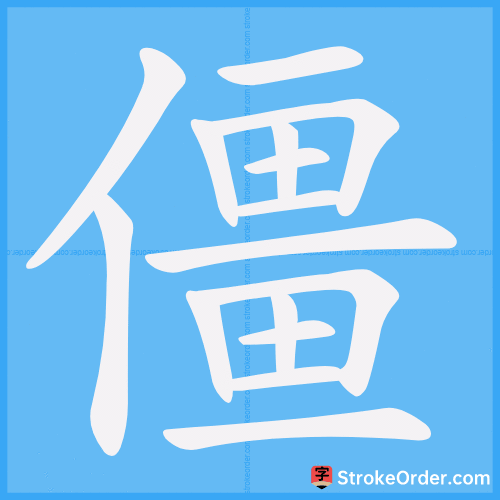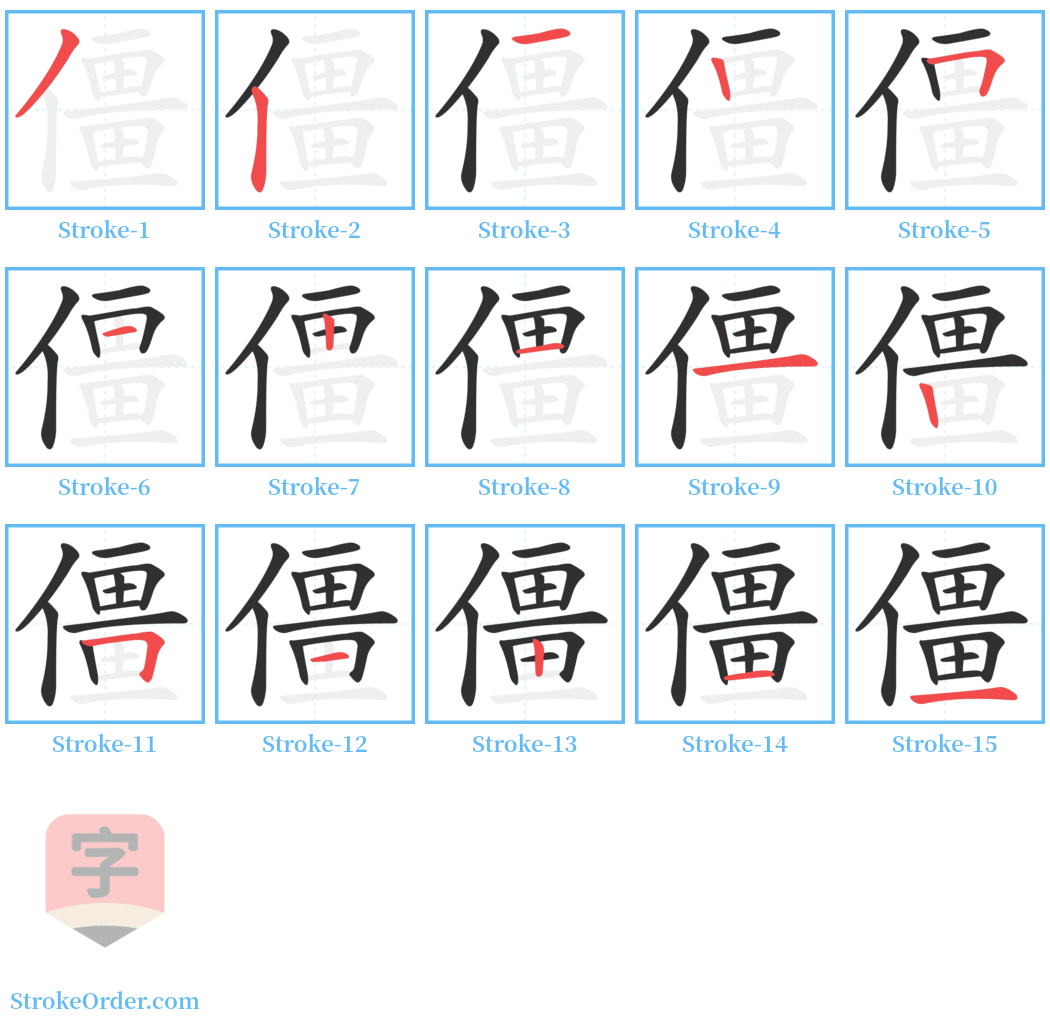僵 Stroke Order
Animated Stroke Order of 僵

Stroke Order Diagrams for 僵

Step-by-Step Handwriting Guide for 僵

Learn to Write Chinese Characters with Video Tutorials
Watch the video of writing the Chinese character "僵", learn the correct stroke order (笔顺) of the character "僵", and master the standard way of writing the character "僵".
Free Printable Handwriting Practice with Stroke Order: 僵
Printable Writing Practice Worksheet of "僵" in Portrait Orientation (Tian Zi Ge)

Printable Writing Practice Worksheet of "僵" in Landscape Orientation (Tian Zi Ge)

Information of 僵
Pinyin
jiāng
Radical
亻
Strokes
15 strokes
Usage
★★★★★
Definition
rigid / deadlock / stiff (corpse), stiff (corpse)
僵 [jiāng]
1. 仆倒。
[En.] Lie flat.
2. 直挺挺,不灵活。
[En.] Stark, inflexible.
3. 双方相持不下,两种意见不能调和。
[En.] In a deadlock; opinions cannot be reconciled.
1. 仆倒:~尸。
[En.] A fallen body.
2. 直挺挺,不灵活:冻~。~硬。~直。~化。~卧。~死。~冷。~滞。
[En.] Stark due to freezing; stiff; rigid; lifeless; cold; immobile.
3. 双方相持不下,两种意见不能调和:弄~。~持。~局。
[En.] Deadlock; opinions in conflict; stalemate.
动:
【本义】: 仰面向后倒下
[En.] The original meaning: to fall back lying flat.
1. 同本义
[En.] Same as original meaning (to lie flat).
引:
1. 《说文》:僵,偾也。
[En.] "Jiāng" means to fall back.
2. 《吕氏春秋·贵卒》:鲍叔御公子小白僵。 注:“偃也。”
[En.] From "Lüshi Chunqiu": Bao Shu rescued the young master and they fell back. Note: "to recline."
3. 《史记·苏秦传》:佯僵而弃酒。 注:“仆也。”
[En.] From "Records of the Grand Historian": Pretended to fall back and abandoned the wine. Note: "to fall."
4. 《汉书·梁平王襄传》:即诈僵仆阳病。
[En.] From "Book of Han": Feigned falling to the ground due to illness.
5. 唐· 柳宗元《柳河东集》:僵仆烦愦。
[En.] From Tang Poet Liu Zongyuan's works: Stricken and fallen, troubled.
6. 清· 薛福成《观巴黎油画记》:偃仰僵仆。
[En.] Qing scholar Xue Fucheng's observation of Parisian painting: Lying back in a fallen state.
例:
如: 僵死(倒地死去;倒地死去的人)。
[En.] For example: "stiff dead," meaning "to die and fall to the ground."
2. 死去
[En.] To die.
引:
1. 《吕氏春秋·贵卒》:伶悝僵。 注:“毙也。”
[En.] From "Lüshi Chunqiu": The performer falls. Note: "to die."
例:
如: 僵仆(死去);僵坠(死亡坠下)。
[En.] For example: "to fall dead" or "to die by falling."
3. 收敛笑容,使表情严肃
[En.] To become stern.
例:
如: 他僵着脸。
[En.] For example: "He has a stern face."
形:
1. 僵硬。难以活动
[En.] Stiff; difficult to move.
引:
1. 《灵枢经·癫狂》:癫疾始作,先反僵。
[En.] From "Classic of Difficulties": Stiffness appears first in the beginning.
例:
如: 僵立(直立不动)。
[En.] For example: "to stand stiffly."
2. 呆滞
[En.] Dull.
例:
如: 僵呆; 僵冷(冷漠而无生气)。
[En.] For example: "stubbornly dull" or "emotionlessly cold."
3. 双方相持不下,事情难于处理,处于停滞状态的
[En.] In a deadlock; in a stagnated state.
例:
如: 僵局; 僵持。
[En.] For example: "deadlock" or "stalemate."
dead but showing no signs of rigor mortis / to die hard (idiom) / to die yet not be vanquished (idiom)
Input Method for 僵
Pinyin
jiang1
Wubi
wglg
Cangjie
omwm
Zhengma
nckk
Four Corner
21216
Unicode
U+50f5
Same Pronunciation Characters